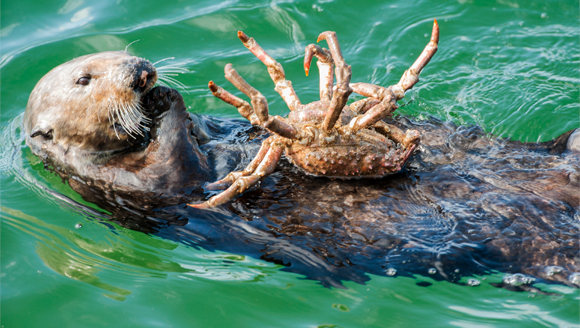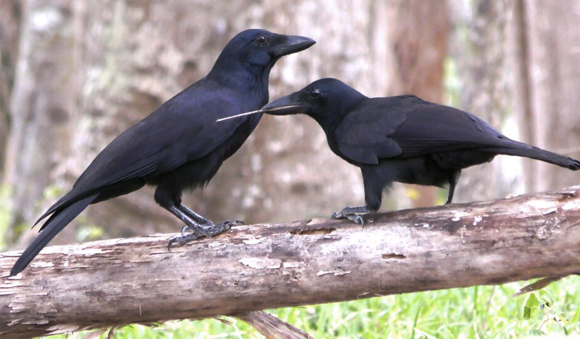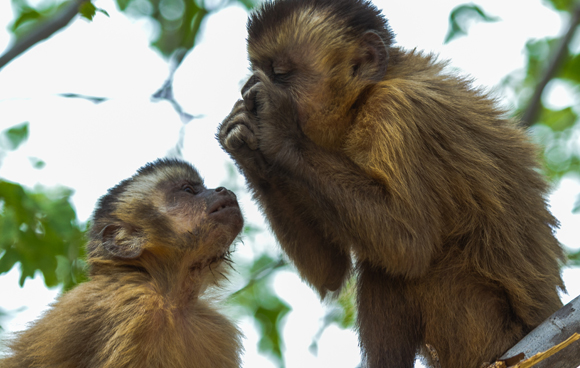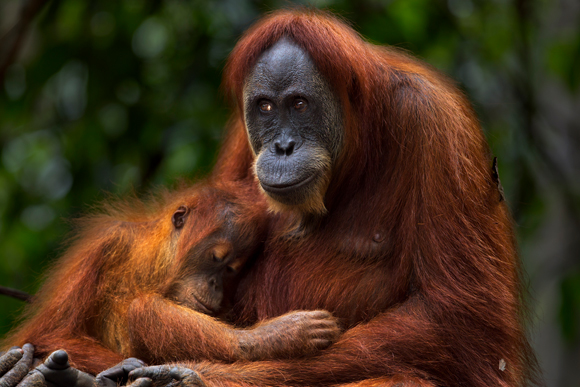From chimpanzees to crows, from dolphins to octopi: Different species of animals use tools around the world. Why did this ability develop in only a few species, and why them?
"That was what was supposed to make us most unique at the time. Humans, and only humans, used and made tools, we were defined as ‘man the toolmaker.’ And so now we have to redefine man, redefine tools, or accept the chimpanzees as human.”
This is how Jane Goodall, the renowned chimpanzee researcher, described in a video produced by the institute that bears her name her thoughts after first seeing a chimpanzee use tools. It was in the Gombe National Park in Tanzania in the early 1960s. The chimp she watched took a long blade of grass, put it into a termite nest and pulled it out, now covered with angry insects that bit the “invader” and held onto it. The chimpanzee then brought the blade to its mouth and picked the termites off with its lips.
A Jane Goodall video describing the discovery of tool usage:
That was the first scientific documentation of animals using tools in nature – something formerly considered, as Goodall said, to be done exclusively by humans. Tools are around us every day, all day, and we use them to eat, work, play, clean the house or ourselves – to do almost anything. There is no doubt we are the most technological species on Earth, but as Goodall showed, we aren’t the only ones using tools. Almost 60 years after her discovery in Gombe, we know a lot more not only about the different tools that chimps use, but also about other animals that share this ability: Apes, monkeys, dolphins, and even birds. However, this behavior is still rare in the animal kingdom, and we don’t know why one animal uses tools when other species, close to it evolutionarily, do not. Some think the secret lies in the cognitive capabilities of the animals, others claim that many species simply don’t need tools. And perhaps the key to using tools is sociability and tolerance.
What exactly is a tool?
To discuss the use of tools we first need to define what a tool is, and that’s not as simple as it sounds. Does a bird building its nest use tools? What about an elephant sucking water with its trunk and then transferring it to its mouth? Crows are known to take nuts in their beaks, fly high and thrust them downwards so that they break and crack when they hit the ground. Are they using the ground as a tool?
Most researchers will give a negative answer to these examples. The common definition of a tool is an object that is not part of the animal, that can be lifted – i.e., not a permanent part of the ground – and that the animal uses it to change the situation of another object or animal, in order to achieve a certain goal. Still, there is no single agreed-upon definition for what a tool is.
In the case of Goodall’s chimpanzee, the blade of grass was a tool that changed the state of the termites when it lifted them out of the nest, and it enabled it to achieve the goal of eating insects. When birds build a nest, however, they do not use twigs or any other object and change it. The elephant’s trunk is part of its body, and therefore cannot be seen as a tool. Thrusting nuts to the ground could be seen as “borderline use of tools,” since the crows that do this don’t hold a tool and use it to make a change in the nut, but a change does occur nonetheless, because of their action.
Furthermore, the researchers differentiate between the use of tools on a constant basis by all individuals of the species, which looks like innate behavior that does not need to be learned, to behaviors that are learned. The first type include, for example, antlion larvae that dig holes in the sand and wait for their prey to fall into them, and if it looks as though their prey may escape, they throw sand on it and make it fall straight towards them. In this article, we’ll focus on the second type, tool usage that the animal needs to learn: By itself, by watching others, or, most commonly – by doing both.
Mammals with tools
Who uses tools in the animal kingdom? Iis Maybe not surprisingly, the species closest to us, monkeys and mostly apes, show the strongest tendency to make tools and use them. The masters of tools, if we don’t take humans into account, are, of course, the animals closest to us: the chimpanzees. Except for termite “fishing” - and in some places ants as well - chimpanzees across Africa use a variety of materials for various purposes. They crack nuts using sticks and stones; they gather rainwater that has accumulated in wells and holes in tree trunks using “sponges” from folded leaves or moss, that they put in the water and then bring to their mouths; they use sticks to open bee hives and reach the coveted honey. Chimpanzees have also been observed sharpening sticks with their teeth and using them to hunt bush babies, a small mammal similar to a monkey. The bush babies tend to hide in hollows tree trunks and, using the sticks, the chimps can jab them without risking getting bit.
A video of chimpanzees hunting bush babies
Orangutans also use tools, although less than chimps. They use sticks to reach tasty seeds of the Neesia fruit, without touching the fibers that surround it, which cause skin inflammation, and also to obtain honey from wild bee hives . Gorillas don’t use tools on a regular basis, but they have been seen using sticks to check the depth of water in a river before crossing it.
In the past 20 years, two species of monkeys have been discovered to use tools on a regular basis. The Black Striped Capuchin (Sapajus libidinosus) in Brazil cracks nuts with hard shells by using stones on “anvils” made of rocks or fallen tree trunks. The crab-eating macaque (Macaca fascicularis) in Thailand use stones similarly, but not for cracking nuts. Instead, it cracks open shells and snails, and sometimes crabs, which it gathers from the sea.
A video of a nut-cracking capuchin:
Outside the primate family, which includes monkeys, apes, and humans, the use of tools is rare. The few other examples include sea otters, in which specific populations crack shells with stones, just like the macaque, and dolphins that cover their snouts with sea sponge when they look for prey on the seafloor. Researchers believe the sponge protects them from sharp stones and coral.
A study published in October 2019 showed tool use among Visayan Warty Pigs (Sus cebifrons), a species found in the Philippines. Pigs are known to be smart animals, and these wart pigs were seen holding pieces of bark in their mouths and digging holes in the ground with them. They do so to prepare for building a nest: They pad the shallow pit with leaves, and that’s where the female gives birth. This use of tools is rare, seeing as how it does not have to do with getting food. This behavior, however, was only spotted in three pigs in a zoo, and further research is needed to determine if it is common behavior in the wild.

Cracking shells and other sea life using stones. A sea otter in California eating a crab. Photo: SPL, Doc White
Bird brain?
We tend to think of birds as less intelligent than mammals, if not downright stupid. Their flight ability amazes us, but we attribute reaching conclusions, planning ahead, understanding cause and effect mainly to our group, the mammals, and often only to a certain part of it. But even if it doesn’t really flatter our ego, usage of tools of various types has definitely been sighted among the winged animals.
The award for excellence in the use of tools by birds apparently goes to New Caledonian Crow (Corvus moneduloides), black birds that live in the New Caledonian archipelago in the Pacific Ocean. These crows are known for their wisdom and resourcefulness. As we mentioned earlier, other crows tend to throw nuts from heights to crack them, and even lay them on the road so that passing cars will run over them. The New Caledonian crows, however, show a much higher level of tool usage. They pick thin branches from trees, take off the leaves, and sometimes bend the edges into a hook, using their beaks. Then they put the tools they made into slits in branches, and extract fat larvae hiding in them. Besides the sticks, they make clever tools from leaves of a thorny plant that grows on the islands.
If the crows behave similarly to how the chimps do when “hunting” termites out, using sticks and grass, the Egyptian Vulture (Neophron percnopterus) is the birds’ representative in the “cracking using a stone” method. The vultures don’t crack open nuts or shells, but lift stones with their beaks and throw them at ostrich eggs until these break, enabling them to devour their contents. This behavior has been seen at the Khai Bar nature reserve in Yotvata, Israel, where they also have Brown Necked Ravens (Corvus ruficollis). The researchers found out the ravens as well get to the delicious eggs with a clever technique. They don’t use tools, but wait for the vultures to crack the eggs and then steal what’s inside.
Video of an Egyptian Vulture cracking open an egg:
There are also birds that do what other animals (except for humans) don’t: They use bait to fish. There are more than ten species of birds, half of them types of Great Herons, that have been seen throwing pieces of food into water, and then catching fish that rise to the top of the water. It seems that the birds know what they’re doing: They’re throwing into the water only things that float, and always close to the shore, where they can easily reach the fish that are drawn to the food.
Video of a Great Heron fishing
Finally, even among mollusks there are animals that cleverly use tools. Octopi near Indonesia have been seen carrying halves of coconut shells, sometimes two halves. When they spot prey, they quickly hide under the shell, or, if they have two, put those around them like an armor, closing the opening with their tentacles. They use the coconut shell also as a moving den – when they want to stop for the night, they stick it in the sand, bury it, and crawl inside. The next day, they can take out the shell, clean it with water currents and keep going. How do they manage to carry two halves of coconut shells? No problem: they put one half inside the other, like bowls.
Video of octopus carrying a coconut shell
Why so few?
All these examples show that using tools helps animals do different things, especially obtain food that is difficult, or even impossible to get without the tool. There’s no doubt that the ability to use tools developed many times throughout evolution, in many different groups. And yet, most of the animals, even the majority of mammals and birds, do not use tools. Why is this ability so rare?
One answer seems obvious: Only animals smart enough to use tools do so, and there aren’t many like that. Using tools requires high mental capabilities. The user needs to understand what it needs to do with the tool, and plan how to use it in order to achieve the desired result. Working with a tool often requires time to reach the desired goal – a chimp fishing for termites with a stick will sometimes need to turn its back on the nest, take a step away to get a stick, remove the leaves, shorten it to the appropriate length – and only then start fishing. All this requires good working memory, the ability to hold back the urge to immediately go to the nest with the tasty insects, and also the ability to understand and remember what the tool must look like – its size, length, and flexibility.
Holding back that immediate urge is very important when it comes to the fishing birds. The bait they use is usually food, like bread. They could eat it, but instead, hold back and put it into water for the chance to win a bigger and tastier prize. This is a cognitive ability that not every animal is gifted with.
Furthermore, in order to use the tool, the animals need also delicate motor skills – the ability to hold a tool in a hand, foot, or beak and move it precisely into a hole in a tree trunk, for example. Animals that design their tools, like the New Caledonian crows, need especially high-level skills.

High-level skills are required for tool use. New Caledonian Crows, an adult and youngster, picking food from holes in a branch. Photo: Natalie Uomini
But some researchers believe that it’s not the cognitive capabilities that separate tool users from those who don’t use tools. In a study published in 2018, rooks (Corvus frugilegus) that don’t use tools in nature, managed to complete a task that involves capabilities such as comprehending the tool’s effect on its surroundings and the physics relation between the tool, the prize (a piece of food), and the device it is in. A different study compared the Woodpecker Finch (Camarhynchus pallidus), which uses sticks to remove insects from branches, much like the New Caledonian Crows do, with the Small Tree Finch (Camarhynchus parvulus), a relative which does not use tools. The cognitive capabilities of both species were tested in various tasks, including some that are directly connected to the use of tools, and – contrary to the predictions – the woodpeckers fare no better than their relatives.
According to some researchers, it is possible that the use of tools simply isn't helpful enough to most animals. Necessity, goes the saying, is the mother of invention, and if there is no need – i.e., food is sufficient and so there is no need for tools – then invention will not follow. Others believe that there are numerous examples of species that could have gained quite a bit from using tools, yet still don’t do so. For example, the Mariana crow (Corvus kubaryi), which lives in the islands of the Pacific, in an environment very similar to that of the New Caledonian crow. Like the latter species, the Mariana crows also feed mostly on larvae found in trees. It would appear that using tools would serve them just as it does their New Caledonia relatives, but they were never seen with sticks in their beaks. This debate is far from over.
The advantages of sociability
There may be one more thing needed for animals to use tools, besides cognitive capabilities, physical skills, and the needs arising from their habitat or diet. One interesting theory raises the possibility that using tools is widespread mostly among species that live in groups, or in which the young spend most of their time with their parents, and especially if the adults show patience towards the young and let them watch closely when they crack nuts or catch insects with sticks. The use of tools that we speak of is learned behavior, and in most cases studied, it seems the young learn by example from their parents or other adults in the group. The learning also includes a period of trial and error, practice and improvement that the youngster does by itself, but the presence of adults who skillfully use the tools is highly important. In some cases, the youngster’s first use is with a tool that the adult had used before.

Learning from each other. A young capuchin monkey watches an older friend eat a nut. Photo: Shutterstock
Indeed, many of the species that use tools live lives that offer ample learning opportunities to the young. Young chimps stay with their mothers at least 5-6 years and sometimes more, and keep in contact with her even afterwards. They are exposed to other adults in the group, and the females especially allow them to get closer and watch what they do. Orangutans don’t live in groups, but the youngsters stay with their mothers for 7-8 years. Young capuchin monkeys are very interested in nut cracking, and when one of the adults begins to crack a nut they get closer, watch, sniff, and sometimes get their nose right under the stone. They do that even with the male adults, who let them come close and sometimes steal crumbs. The young New Caledonian crows stay with their parents often for the second year of their lives, a rarity among birds, and the parents are very patient with them and even continue to feed them.

Staying with mom at least until they’re seven. An orangutan with her daughter, about 3 or 4 years old. Photo: SPL, Fiona Rogers.
And then there are us, humans ‒ the undisputed masters of tool use. It may not always seem like it, but in comparison to other animals, we’re very sociable, patient, and tolerant. Particularly when it comes to kids. According to this theory, those two traits are tightly connected: We developed our tools – the technology that makes us so unique – maybe not only thanks to our smarts, but also due to our ability to accept the presence of others near us, the ability to share knowledge, to learn, and to teach.
